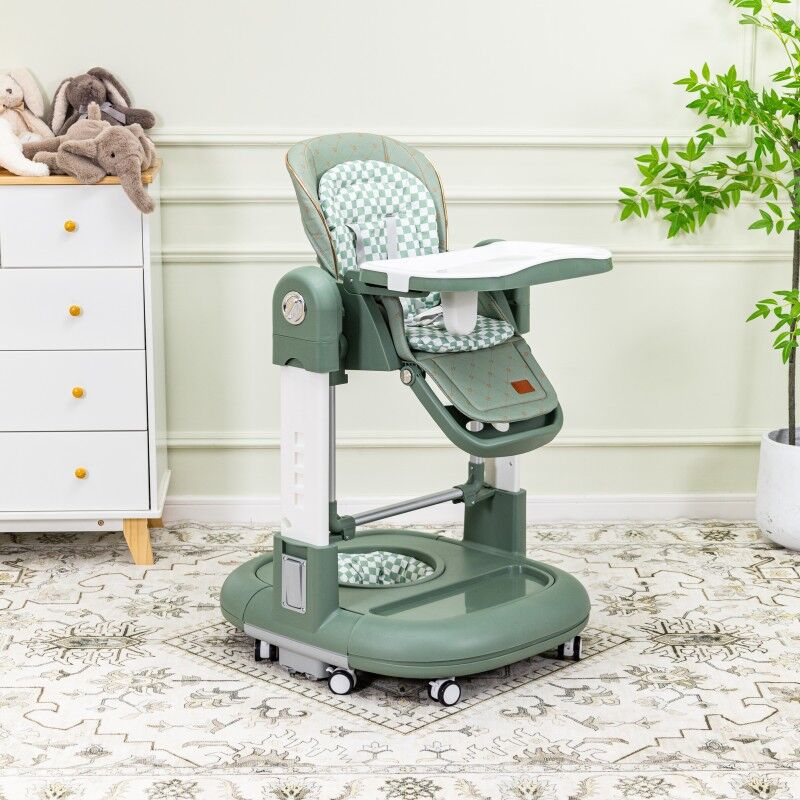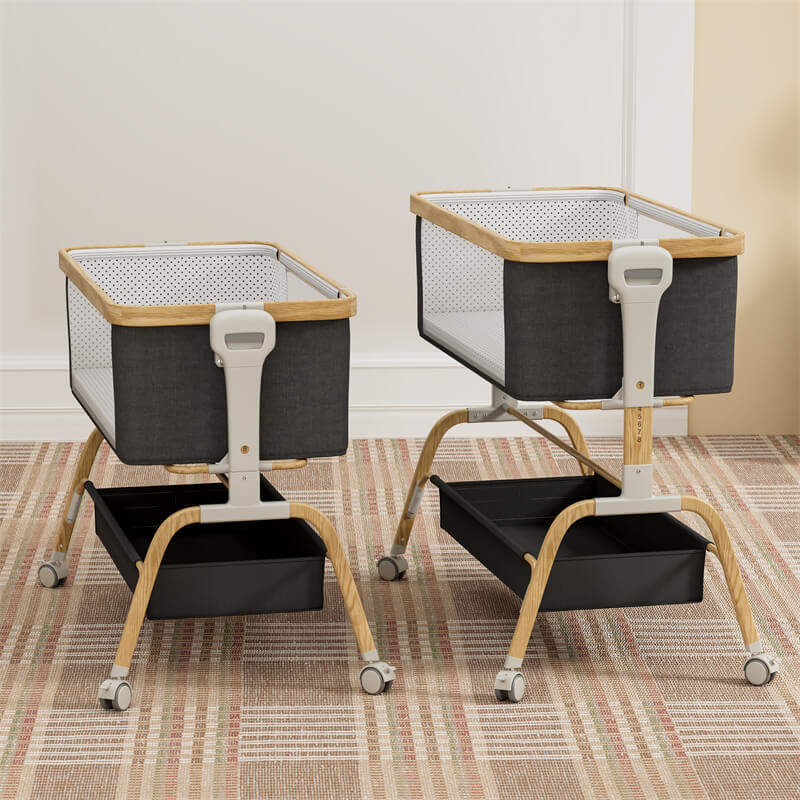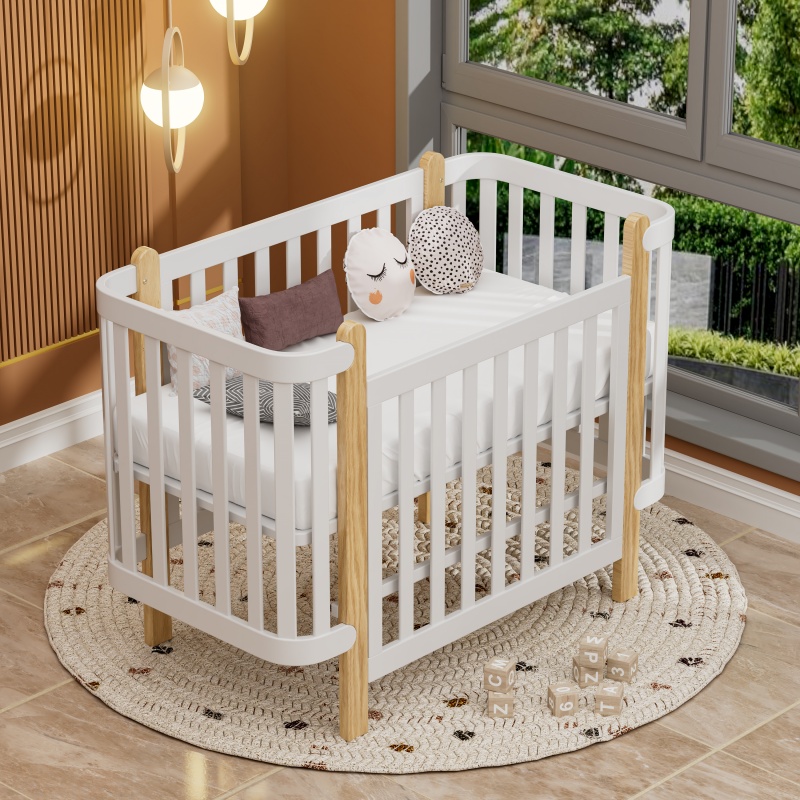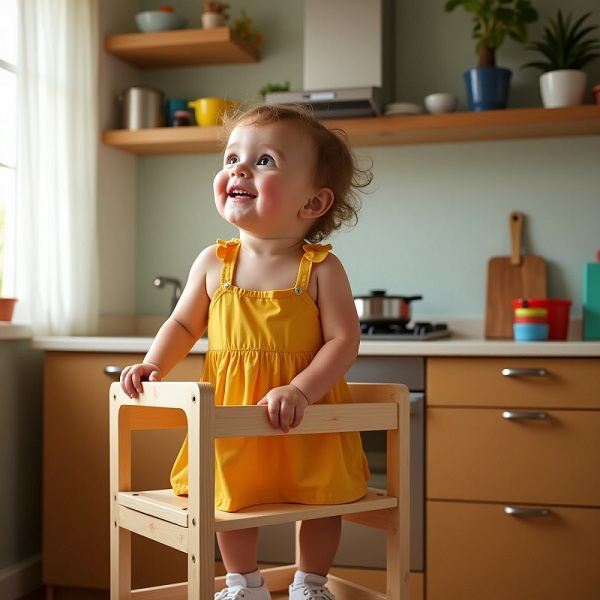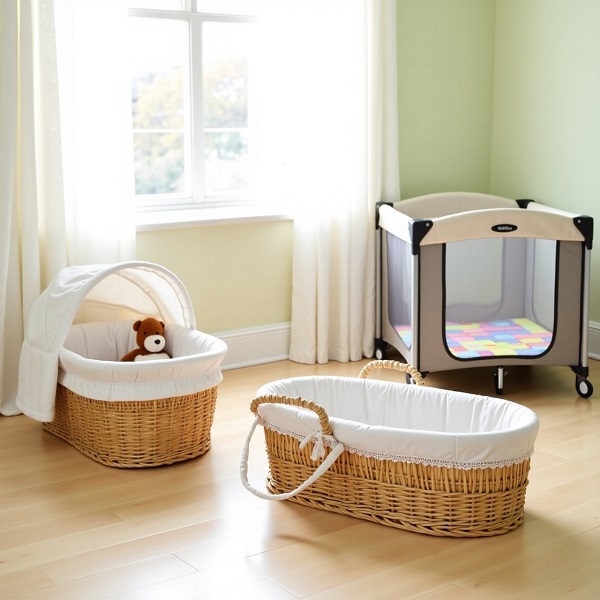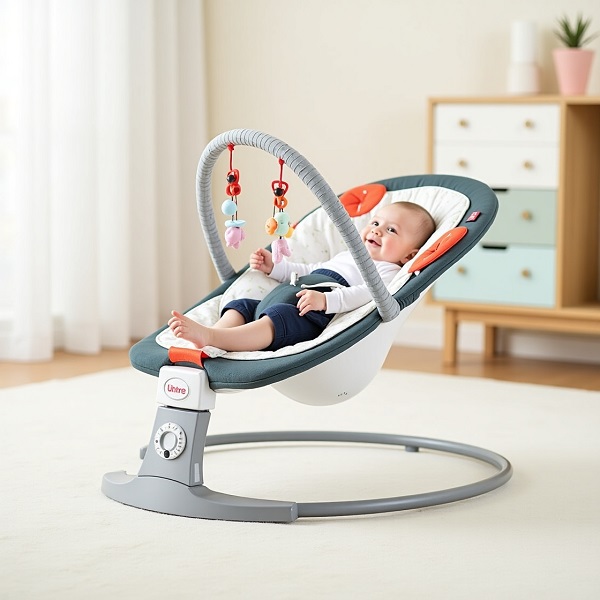In the aisles of baby product stores, new parents often face a common dilemma: choosing between plastic and wooden high chairs. Plastic options offer lightweight portability and vibrant colors but raise concerns about chemical exposure, while wooden models provide natural stability but come with cleaning challenges.
The popularity of plastic high chairs is no accident. Their rise aligns with the widespread adoption of food-grade polypropylene after 2008 EU safety standards banned bisphenol A (BPA), revolutionizing the safety profile of plastic baby products.
Wooden high chairs, meanwhile, embody timeless craftsmanship. According to the North American Hardwood Alliance, sales of solid wood baby furniture have seen 12% annual growth since 2020, mirroring a parental shift toward natural, sustainable materials.
This article breaks down critical factors—from safety certifications to real-world usability—to help you escape the material selection maze with confidence.
Which Material Is Safer for Babies?
Plastic’s “Flexible Protection”
Food-grade polypropylene (PP) shines in its flexibility. When a baby excitedly shifts their weight, plastic chair legs flex slightly like shock absorbers, reducing tipping risks from sudden movements.
But note plastic’s temperature sensitivity: Dark plastic parts in direct sunlight can heat up 14–18°F more than wood. Always use breathable seat pads in sunny areas.
Wood’s “Stable Defense”
Solid wood’s stability comes from its density. Take beechwood: at 45 lbs/ft³
, it’s nearly twice as dense as PP plastic (56 lbs/ft³ / 0.9 g/cm³). This means wooden chair legs of the same size offer superior anti-tip resistance.
Yet wood’s natural grain can hide risks: ASTM standards require knots in wooden chairs to be smaller than 0.25 inches (coin-sized) and never in load-bearing areas.
Chemical Safety
The Environmental Working Group (EWG) found infants absorb chemicals 12x more through skin and breath than adults, making high chair materials critical.
Plastic chairs contain multiple chemicals, but safe brands use non-toxic additives within strict limits. Food-grade PP adheres to EU REACH standards, which cap phthalates (plasticizers) at <0.1% and ban BPA entirely.
Wooden chairs avoid chemical risks in the wood itself, but coatings and adhesives matter. Opt for unfinished beechwood with FDA food-safe glue in mortise-and-tenon joints, avoiding allergy-triggering isocyanates.
Age-Based Recommendations
In summary, plastic materials are more suitable for babies aged 6-18 months because they have more sudden movements during activities. For those over 2 years old, you can gradually transition to wooden models to cultivate a stable sitting posture during meals.
For premature babies or babies with allergies, it is recommended to choose unpainted beech wood chairs in their original color and use linseed oil for regular maintenance.
No matter which one you choose, please confirm that the product label has both ASTM F404 (high chair safety standard) and CPSC certification marks printed on it, which is equivalent to double insurance.
Which Lasts Longer?

When it comes to longevity, wooden high chairs—particularly those crafted from solid hardwoods like oak, beech, or rubberwood—hold a clear advantage. These materials are naturally dense and resilient, allowing them to withstand years of spills, adjustments, and energetic use.
Many hardwood high chairs become family heirlooms, passed down through generations with proper care. Their structural integrity remains intact over decades, thanks to wood’s high compressive strength, which prevents bending or warping under a child’s weight.
Plastic high chairs, while lightweight and easy to clean, face inevitable wear. UV exposure can fade and weaken plastic over time, while temperature changes may cause cracking. Chemical cleaners and repeated stress at joints or folding mechanisms further degrade their durability.
Wooden Chairs excel in durability and reparability. Scratches can be sanded, joints tightened, and finishes refreshed, extending their lifespan to 8–12+ years—ideal for families with multiple children.
Plastic Chairs prioritize affordability and portability but rarely last beyond a single child’s use. Their average lifespan is 3–5 years, with degradation accelerating in high-use scenarios.
For families valuing longevity and sustainability, wood is the wiser investment. For those prioritizing budget or short-term needs, plastic offers convenience at a lower upfront cost—but with a shorter shelf life.
Comfort and Design
Comfort
Comfort here isn’t about plush cushions (though that helps!) but about how well the chair supports their posture, spine, and budding independence.
Many feature a gently curved backrest that cradles younger babies who are still mastering sitting upright. Add in padded inserts, adjustable recline settings, and a five-point harness, and you’ve got a cozy nest for mealtimes. The built-in footrests also let tiny feet rest naturally, preventing that awkward “dangling legs” effect.
However, many high-end wooden models focus on ergonomic posture support and use accessories like cushions, adjustable footrests, and seat inserts.
The stiffness of a solid wood chair is just the thing for nurturing your child’s dining etiquette. When your baby tries to sway, the restrained feel of the wooden armrests reminds them to stay upright. It is often recommended by pediatric occupational therapists for its ability to promote proper posture and body coordination with adjustable seat and footrest heights.
Design
Wooden high chairs crafted from rich oak, sleek beech, or warm walnut, double as statement pieces that elevate your dining space. With sleek silhouettes and natural wood textures, they effortlessly complement farmhouse, Scandinavian, and modern interiors alike.
Plastic chairs, meanwhile, are the pragmatic choice for dynamic homes. Bright colors, lightweight frames, and fold-flat designs make them ideal for apartments, grandparents’ houses, or kitchens where space is premium.
Ease of Cleaning and Maintenance
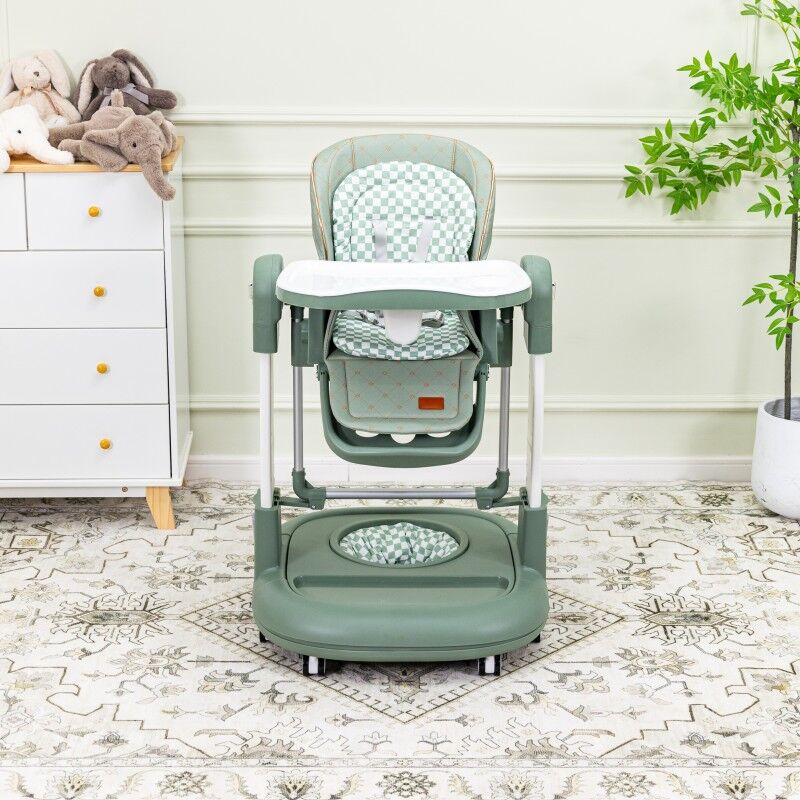
Baby’s dining chairs are always a food battlefield – from dripping rice cereal to splattering juice, cleaning difficulty directly determines the workload of parents.
Plastic High Chairs: Wipe-and-Go Convenience
Plastic chairs are built for mess-prone parenting. Made from smooth, non-absorbent materials like polypropylene, spills slide right off, and most trays pop out for a quick rinse or dishwasher cycle.
The seamless design avoids crevices where food gunk hides, making cleanup a 30-second job. Plus, many models feature removable seat pads that toss straight into the washing machine after a spaghetti disaster.
But plastic isn’t indestructible. Over time, harsh cleaners can dull its shine, and scratches from utensils or toys may leave permanent marks.
Wooden High Chairs: Classic but Demanding
Wooden high chairs offer classic appeal but often demand extra care and maintenance. High-end models use durable sealants like water-based polyurethane to repel spills and stains, but wood’s natural pores mean vigilance is key.
A forgotten yogurt smear can seep into unsealed grain, potentially causing mold growth or warping as time passes. Daily wipe-downs with a damp cloth are a must, and immediate drying prevents moisture damage.
The upside? Wood ages gracefully if maintained. Scratches can be sanded out, and a fresh coat of sealant every few years keeps it looking like new—something plastic can’t match.
The Verdict
Plastic wins for hassle-free cleanup and durability against stains, but it may show wear over time.
Wood demands more effort but rewards you with decades of use (and heirloom appeal) if cared for properly.
Choose plastic for low-maintenance practicality or wood for long-term beauty—just know what you’re signing up for!
Eco-Friendliness Compared
When evaluating plastic vs. wooden high chairs in terms of eco-friendliness, it’s essential to consider the full product lifecycle—from raw material sourcing to production, usage, and end-of-life disposal. While both materials have environmental impacts, wooden high chairs are generally considered more eco-friendly when responsibly sourced and manufactured.
Wood’s natural biodegradability means it breaks down harmlessly over time, unlike plastic. Even better, well-maintained wooden chairs can be sanded, refinished, or repurposed into bookshelves, plant stands, or toddler desks—extending their lifespan for decades. At end-of-life, untreated wood decomposes without leaching toxins.
While some plastics are recyclable, most high chairs mix materials (foam, metal, fabric) that complicate recycling. Though lightweight plastic chairs may use fewer resources to transport, their shorter lifespan often negates this benefit. Low-quality models tend to crack or discolor over time, resulting in frequent replacements and increased waste.
For eco-conscious families, a wooden feeding chair is the clear winner—but only if paired with responsible maintenance and disposal practices.
Cost vs. Value
Initial Cost
Plastic high chairs are usually the most economical choice. Prices for basic plastic models can range from $20 to $70, making them ideal for families on a tight budget or those needing a temporary solution.
In contrast, wooden high chairs are generally priced at the higher end of the spectrum. These chairs are designed with long-term use in mind, often featuring adjustable footrests, height adaptability, and ergonomic support that grows with the child from infancy to adulthood.
Long-Term Value
Plastic’s affordability comes with trade-offs. Most models last only 2–3 years before showing wear like faded colors, loose joints, or cracked trays. They’re rarely resold for much value, and many end up in landfills due to limited recyclability.
Wooden high chairs, while pricier upfront, pay off over time. Crafted from hardwoods like beech or oak, they withstand years of spills, growth spurts, and even toddler tantrums. Many models convert into functional furniture—think toddler desks or standalone chairs—extending their usefulness for a decade or more.
Which Suits Your Family?
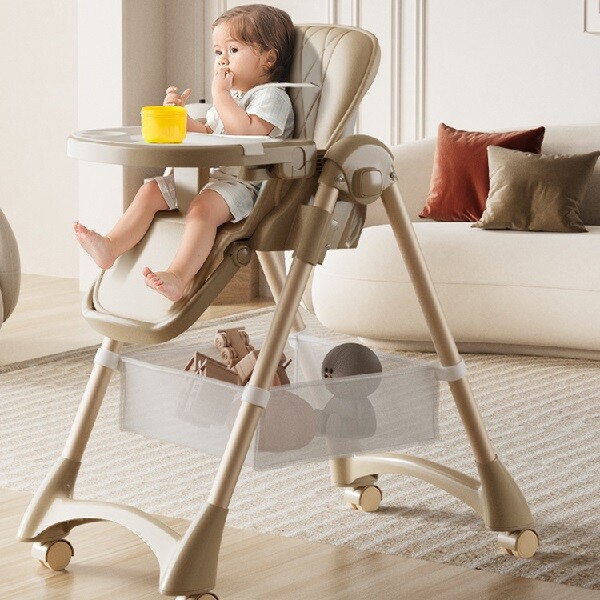
Lifestyle and Space Considerations
If you’re juggling life in a cozy apartment or tight kitchen, plastic high chairs often shine. Their lightweight, fold-flat designs tuck neatly into closets or under tables, making them ideal for small spaces. Frequent travelers or families who dine out often will appreciate how easily these chairs collapse for car trips or storage—no heavy lifting required.
Frequency of Use and Lifespan
Plastic chairs are budget-friendly for short-term needs, perfect if your child is nearing toddlerhood. But if you’re planning another baby soon, hardwood models like beech or oak offer lasting durability. These wooden workhorses withstand multiple kids, growing with your family without losing their sturdy charm.
Maintenance and Daily Use
Plastic wins for wipe-and-go convenience, especially with messy eaters. A quick scrub removes puree splatters, and most trays are dishwasher-safe. While a quick wipe with a damp cloth keeps them clean, wooden chairs need a bit more upkeep—like resealing surface nicks or tightening loose joints as they age.
Budget and Value Expectations
Plastic high chairs are budget-friendly, with many dependable models available for under $50. But for families viewing a high chair as a long-term investment, wooden models justify their higher cost with decades of use. Some even convert into toddler chairs or desks, stretching their value further.
Safety and Comfort Priorities
Both types meet safety standards (look for ASTM or JPMA certifications), but comfort varies. Plastic chairs often include padded seats and reclining backs for younger babies, while wooden designs excel in ergonomics. Adjustable footrests and seat heights promote healthy posture, making mealtimes comfier as your child grows.
Conclusion
Choosing the right high chair means finding the right balance between safety, functionality, and your family’s specific needs. From a safety perspective, products that have passed both ASTM F404 and CPSC certifications are preferred.
According to the American Academy of Pediatrics, plastic high chairs are more suitable for babies aged 6 months to 2 years old. Their light and easy-to-clean characteristics meet the needs of young children for frequent feeding and exploration. Children over 2 years old can gradually transition to wooden styles, and the stable structure helps to cultivate a good sitting posture.
In terms of durability, for families with multiple children or those who plan to use it for a long time, the average service life of hardwood materials is more cost-effective. For small households or short-term needs, plastic models with metal reinforcements are more economical.
Recommended Related Articles:

